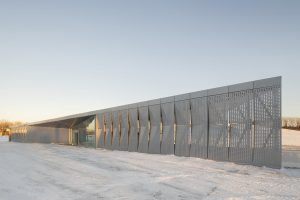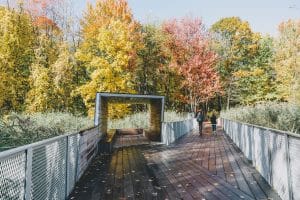- April 12, 2023
Promoting health, well-being, and activity outside and around built environments with nature and design
Between hot summers and frigid winters, Northern cities face the challenge of balancing climate resilience with liveability through four-season design. With growing populations, indoor comfort is a necessity that comes first, but what about the exterior comfort found in public and private spaces?
Climate variability in countries like Canada present their own challenges because of varying degrees of humidity, temperature, shade, light, and wind, but these conditions also help guide how we create and enrich outdoor spaces that are just as restful and restorative as they are adaptively sustainable and biodiverse, benefitting our environment as much as it does our health and well-being.
With modern comforts like heating and air conditioning, we can sometimes forget how important and beneficial it can be to head outdoors no matter the time of year—but the right designs can change that.
Comfort in the great outdoors
Comfort is crucial to outdoor spaces of quality, and their quality gives back to the life of cities. When designed thoughtfully, comfort can give back in ways ranging from making us feel safe and that we belong to providing us with genuinely appreciable acoustic, olfactory and visual elements, convenience, and physical comfort through climatic protection.
One of the best ways then that we can measure exterior comfort comes down to how animated four-season cities’ streets and spaces are. But what kinds of design elements can we incorporate to encourage four-season activity? How can we balance what architect Lisa Heschong calls thermal delight—the physical sensations and cultural meanings associated with changes in temperature—in both summer and winter extremes for city streets, parks, and commons for private and public buildings?

Guided by nature, our Northern designs in Canada can not only be influenced by the four-season climate they’re in, but also add a distinctive character to the places we call home, where what we do for comfort during one season can complement what we need in the other.
“In Canada, we tend to look at Scandinavian cities as leading examples for four-season design, but ours is a leading example as well,” explains landscape architect Patricia Lussier. “Canada’s varied climates influence way we design spaces, where their multifunctionality follows the changing of the seasons.”
Common features like shelter from the wind in winter can provide shade in the summer; lush indigenous vegetation and urban forestry can cool a courtyard while cutting down on chillier temperatures in winter, reducing the likelihood of flooding, air pollution and urban heat island effects; access to water in the summer can soothe and cool while providing ice skating later in the year; and opting for materiality like wood instead of conductive ones like metal can provide biophilic comforts no matter the time of year.
Microclimates: Creating space where we want to be
Context is essential when planning for the outdoors: As new public spaces like the windswept location of Place des Montréalaises can be customized from the start with features like perennial plant life to bridge seasonal gaps, longstanding spaces can be adapted as well. Parc Jean-Drapeau’s Espace 67, for example, brought versatility back to its park setting by combining nature and culture, embedding areas with varied ambiances to stage both summer and winter festivities.

Wherever they are, four-season spaces are best when they are surrounded by or have close access to nature with complementary materials, forms, textures and colours that create coherent wholes while adapting to seasonal changes. This can be found in the city parks like Montreal’s central Mount Royal park and the nature parks of Bois-de-L’île-Bizard, Bois-de-Liesse, and Pointe-Aux-Prairies, where landscapes adapt to the seasons and become as equally important for cross-country skiing and snowshoeing as they are for picnicking and fauna and flora observation.
Outdoor designs must also be made with the intention to activate through play and socialization, where space is activated as often in summer as it is in winter. By giving priority to pedestrians and cyclists of all ages and abilities, and making all-season maintenance, operations, and environmental responsibility central to design, we can see remarkable social, economic, and environmental returns for our communities.
Bringing four-season space to life
Architects and designers can work hand-in-hand with local organizers to take thermal issues and microclimate creation into consideration, turning outdoor space into seasonally adapted canvases. Coming from Montreal, we’ve seen this with past winter projects like the stations hivernales of 2020, the public art of Luminothérapie, and activities of Montréal en Lumière in spaces that host just as many activations in the summertime.
These moments of leisure and recreation begin with places that need shelter, access to water and heat, and perennial vegetation such as conifers, tall grasses, and other plant life to not only break the wind but beautify space through appearance and experience.
“If you plant trees to have a full canopy, it creates a natural shelter with windbreaks, creating a cushioned impact. Sound is absorbed as well, giving a very soft ambiance to exterior spaces,” Lussier adds.
Rather than thinking of our cities as a series of buildings to occupy, they must be reconfigured to consider the space in between, a created space through urban microclimate development. Directly affecting people’s living environments, they can be created and adjusted by design to enhance the resilience of four-season cities, even in the face of climate change. Without them, temperature fluctuations can restrict activities in outdoor environments and their accessibility, negatively impacting urban life.
If we apply a climatological way of thinking to our planning and design, however, the challenges which the hottest summers and coldest winters bring to anything from buildings and streets to neighbourhoods, whole cities, and regions can be seen as opportunities for greater sustainability as well as health and well-being for everyone.
Embracing the shift, channeling the elements
It’s easy to look outside and see uncomfortable weather, hot or cold, and opt to stay indoors. But if we know that the built world environment is designed to maximize our comfort outside, then cities’ private and public spaces become discoverable and appreciable in new ways.
“When four-season designs for exteriors are designed through a filter of comfort, environment and culture are embraced in built environments that channel natural elements,” says Oscar Hernandez, Lemay’s Technical Director in Building Performance and Sustainable Strategies.
“By spending time outdoors in both natural and social spaces, health and happiness are improved, as it’s been shown to improve mental health and moods with lowered stress while encouraging physical activity and improving our immune systems, cardiovascular health, and metabolic health.”
There are new frontiers ahead: We can keep pushing to optimize our cities’ public realms further to assure there’s always year-round programming and comfort, where our summer activities can be adapted to winter and vice versa. That’s because outdoor space augmented with four-season comfort doesn’t only have personal benefits, but they improve our bottom lines and civic life with long-term financial returns, greater social acceptability of our cities, and stronger civic pride.
There are a lot of ways we can rethink our cities’ outdoor and indoor spaces to be regenerative; learn more about what kinds of actions can be taken with NET POSITIVE™.